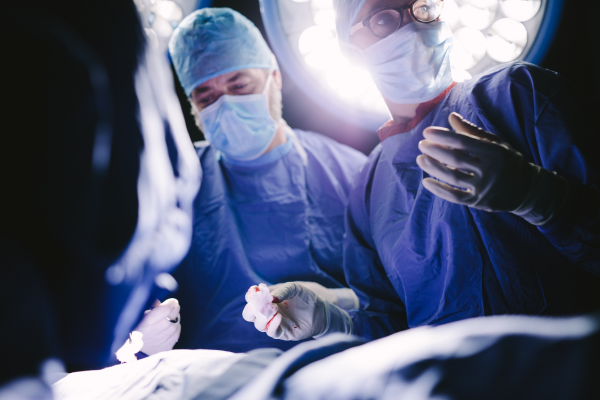From 2018 to 2022, 120 operations were carried out in the two locations of the Hub, the Irccs Institute of Neurological Sciences of Bologna at the Bellaria hospital and the Neuroscience department of the University Hospital of Modena, in Baggiovara. The point today in the Region on the occasion of the conference ‘Epilepsy surgery in Emilia-Romagna’
September 22, 2023 – Important increase in Emilia-Romagna of the number of epilepsy surgeries starting dal 2018when the Region decided to establish a Integrated hub on two locations for the surgical treatment of the diseaseborn on the basis of the evidence of effectiveness of epilepsy surgery published in international literature.
Conceived with the aim of strengthen the regional network dedicated to people with epilepsy and make the surgical process more efficient thanks to the “Hub and Spoke” model, the integrated Hub works on two locations: the Irccs of Neurological Sciences of Bolognaat the Bellaria hospitaland the integrated department of Neurosciences of the University Hospital of Modenaat the hospital in Baggiovara. Supporting the Hub is the regional Spoke reference network, made up of the operational units of Neurology for epilepsy in adulthood and the operational units of Neuropsychiatry of childhood and adolescence and of pediatrics for epilepsy in developmental age.
The two centers together, between 2018 and 2022they carried out 120 interventions (62 in Modena and 58 in Bologna) a significant number if we consider that throughout Italy – according to data released by the Italian League against Epilepsy – there are around 300 per year.
The surgical path for epilepsy is illustrated today in the city of Bologna, in viale Aldo Moro, on the occasion of conference “Epilepsy surgery in the Emilia-Romagna Region”. The meeting, attended by specialists from the two Hub locations and numerous experts in the sector, has two objectives: to inform all professionals involved in the management of people with epilepsy on the diagnostic and therapeutic paths developed in recent years, and to promote research neurological and neurosurgical clinic on the surgical treatment of epilepsy, while promoting integration between the Hub and the Spokes, i.e. the Neurology operating units and the Child and Adolescent Neuropsychiatry and Pediatrics for epilepsy operating units in developmental age.
“The results we have achieved in such a short time – comments the regional councilor for health policies – Raffaele Donini– indicate that the decision taken a few years ago to strengthen the regional network dedicated to people with epilepsy with the creation of an integrated regional hub across two locations was going in the right direction. At our hub, patients find a highly professional and cutting-edge response on the national scene. Having increased the surgical operations carried out in such a short time means having increased the possibilities for these people, who often experience a disabling condition, to have a better quality of life and recover personal autonomy”.
“The diagnostic investigation allows us to obtain multiple and precious information on the individual patient – explains the professor Stefano Melettidirector of Neurology at the University Hospital of Modena – which allow us to choose the most effective therapy based on the brain lesion from which the epileptic seizures arise. The creation of the hub center – continues Meletti – aims to concentrate the surgical cases in two qualified centers which respectively constitute the reference centers of the respective Vast Areas of competence”.
“The intervention – specifies the professor Giacomo Pavesi, director of Neurosurgery at the University Hospital of Modena – consists of a set of procedures for localizing and removing the regions of the cerebral cortex from which epileptic seizures originate. These are patients with epilepsies who usually do not respond adequately to treatment with drugs and for whom surgical removal of the epileptogenic area can lead to a significant improvement in the quality of life and complete seizure control.”
“Since the new project started,” he comments Roberto Michelucci, director of Neurology Bellaria Hospital IRCCS ISNB Local Health Authority of Bologna – the Bologna Hub has recorded a clear increase in patients operated on with success rates (intended as freedom from crisis) in over 80% of cases, in line with the main European epilepsy surgery centers. Furthermore, in the last year, thanks to regional funding and specifically trained neurophysiologists, the Stereoelectroencephalography (SEEG) activity was inaugurated in Bologna, which allows the identification of the epileptogenic area by recording seizures even in cases in which the EEG of surface is not conclusive”.
“Despite the difficulties linked to the pandemic, the Epilepsy Surgery program continued to develop – he specifies Matteo Martinoni, Neurosurgeon IRCCS ISNB-. In fact, in addition to the consolidated craniotomy and vagal stimulation techniques, invasive diagnostic activity (SEEG) began at the IRCCS in 2022 through the implantation of intracerebral electrodes, with the possibility of carrying out radiofrequency cerebral thermocoagulations. This method is now possible thanks to the acquisition of a robot and an intraoperative CT scan with regional funds. These technological advances combined with the constant training of specialized personnel make the IRCCS ISNB Epilepsy Surgery Center at the forefront in the Italian and international field with the possibility of providing a complete response to the problem of drug-resistant epilepsy”
For further information (119.1 KB)
